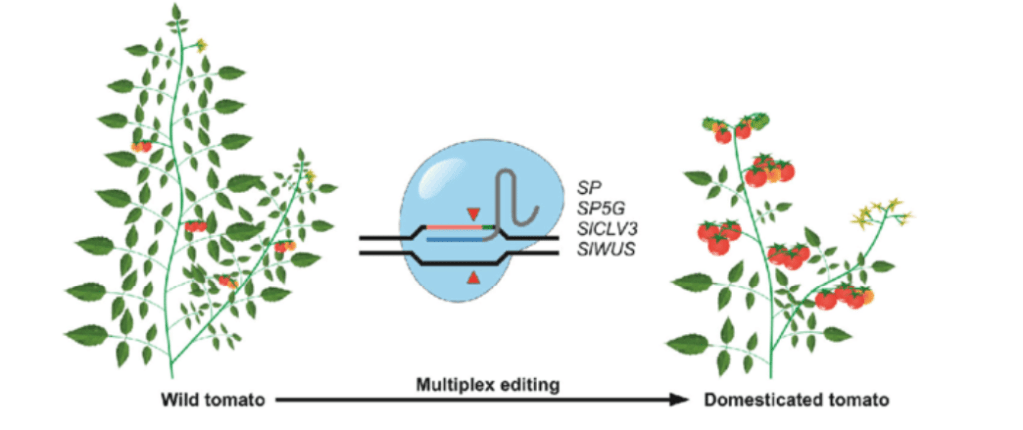
The world’s food supply depends on about 150 plant species, but this number could increase, even considerably. In fact, 250 species are considered to be fully domesticated, while 7,000 are semi-domesticated and 50,000 are edible. In the genomic era domestication may not require centuries and millennia, as was the case in the early days of agriculture. The process could happen at an accelerated pace, within a few years, taking advantage of modern knowledge about useful traits and new tecnologies such as gene editing.
Common crops have gained optimal agronomic performance through domestication and breeding. Wild plants do not, so yields are poor and harvesting is difficult. But the latter may harbor traits worth reintroducing into the former, such as resistance to disease and environmental stress. “The classic approach is to transfer useful wild traits to crops. The alternative is to domesticate wild plants by transferring yield-related traits,” Silvio Salvi of the University of Bologna explains.
The proof of principle that the alternative works, and in some cases may be the easier route, came in 2018, with two papers published in Nature Biotechnology. Both groups showed that it is possible to domesticate the wild relative of tomato (Solanum pimpinellifolium) “de novo” and in a “fast forward” manner by resorting to gene editing. Also in the same year was reported in Nature Plants the domestication of ground cherry (Physalis pruinosa), a plant from Central and South America that is difficult to grow but appreciated for its delicious orange berries. Thse results inspired an international effort to re-domesticate the wild relatives of some of the most important crops including rice. A group from China, in particular, managed to introduce six agronomically relevant traits – such as reduced seed dispersal and panicle shape – into the Oryza alta species (see their Cell paper).
“Developing new plants suitable for cultivation is interesting from a scientific point of view, but it is only the beginning,” Salvi says. Laboratory exploits do not necessarily become commercial successes – it’s up to farmers and consumers to decide what to grow and put on the table.
Nowadays, for example, we consume a huge amount of potatoes, which three hundred years ago were still looked upon with suspicion by European paesants. Kiwis, on the other hand, began to be marketed in New Zealand around 1930, and in less than a century they have conquered the world. Probably the success of the new strategy will depend mainly on the right choice of wild or semi-domesticated plants to work on. “Domestication of perennial relatives of widely consumed annual species could have a positive impact on the environment,” Salvi argues. They could be planted every 5 or 6 years from seeds, instead of every year, meaning reduced profits for the seed industry but also less soil erosion. Basically, instead of trying to make perennial the annual grains that we’ve been growing for thousands of years, we could make cultivable their wild ancestors that are already perennial, such as teosinte for corn.
In Italy, in particular, there is a wild wheat (Dasypyrum villosum) that grows at the edge of fields and occasionally crosses with durum wheat. “It has tiny seeds and fragile ears, and it is prone to lodging, but it could be domesticated by altering the size of the plant and the seed.” Salvi points out that it could carry genes for disease resistance, but that for now it’s just an idea. Among wild plants, moreover, might be hiding something like a new arugula, a type of salad that has seduced palates and the market within a few years. At the moment, the Italian geneticist is working on domesticating “grespino” (Sonchus oleraceus), a wild lettuce already used for salad blends in southern Italy and other Mediterranean areas. Turning it into a true crop will require standardizing the germinability of the seeds and controlling flowering, which robs the leaves of nutrients, making the lettuce less palatable. The EU program funding the project, however, does not involve editing, so he has to proceed the slow way, by using classic breeding.
Salvi’s group has also been working on a biomass plant (Arundo donax) for a decade. This common reed is good for carbon storage and, once domesticated could be grown on marginal land to provide biomass for energy uses. There is one such precedent: miscanthus. This species has already been made cultivable by a British public-private consortium, with a view to a circular economy, but has not yet fully met commercial expectations.
[The Italian version of this article was published in AgriScienza; image: BMC Plant Biology]
